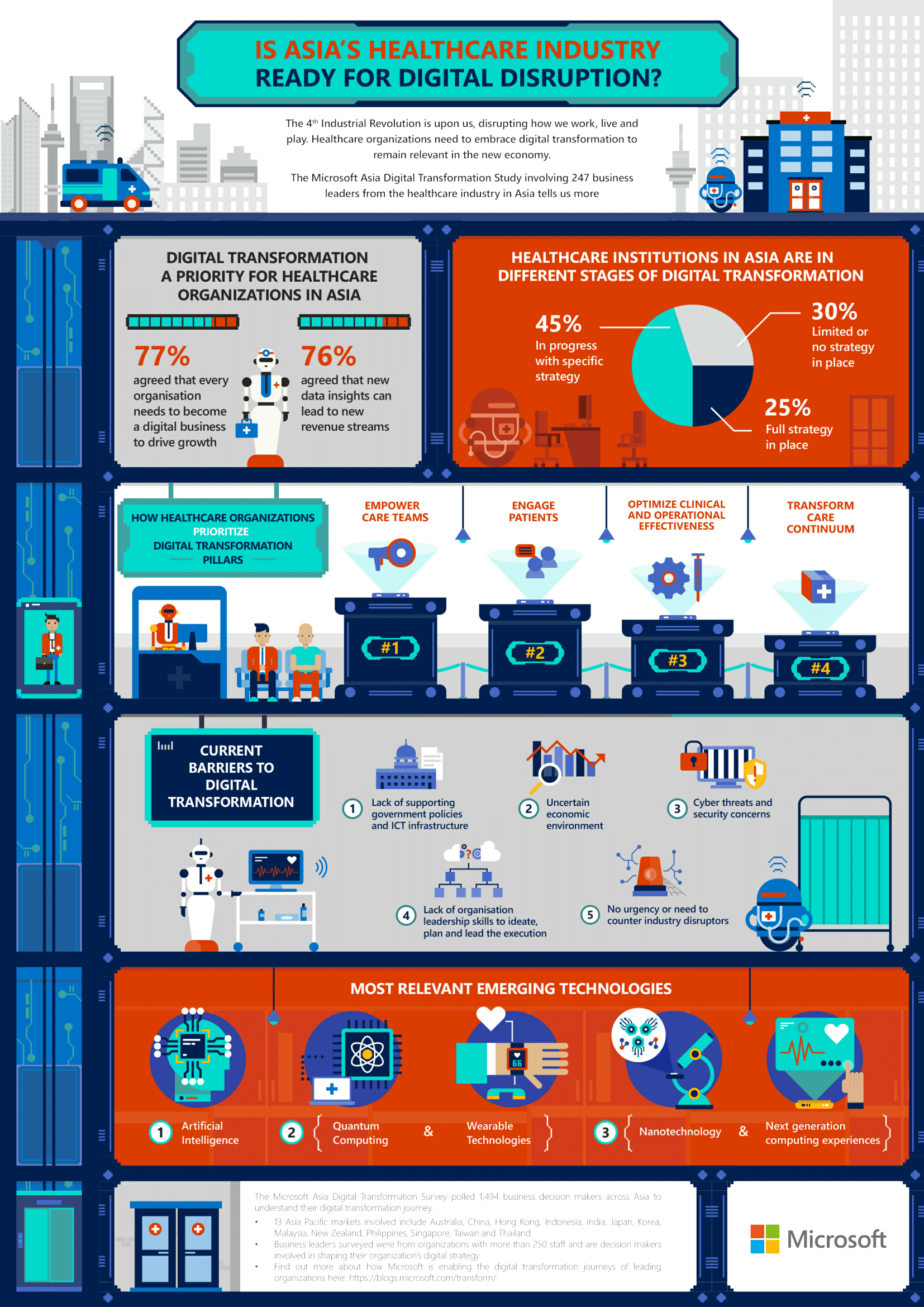Business leaders in Asia Pacific’s healthcare industry are showing urgency in embracing the 4th Industrial Revolution, where 77% of them believe that they need to transform to a digital business to enable future growth and yet only 25% said that they have a full digital strategy in place today. These are some of the key findings of the Microsoft Asia Digital Transformation Survey[1] to understand how business leaders in the healthcare sector are embracing the digital era.
Technology advancements have ushered in the 4th Industrial Revolution, where cutting-edge technologies such as Internet of Things (IoT), artificial intelligence (AI), advanced data analytics, and mixed reality that are powered by cloud computing are creating limitless possibilities in transforming the way people work, live and play. This revolution, compounded by on-going challenges faced by the healthcare industry, such as the evolving healthcare needs due to changing demographics, rise of chronic diseases, shortage of caregivers and cost of quality healthcare, is ushering societal and economic changes at an unprecedented pace. However, the 4th Industrial Revolution also has the potential to be truly game-changing for the healthcare industry. Taken together, the potential for merging physical, digital and biological systems can enable the healthcare industry to achieve its aspirations.
The Microsoft Asia Digital Transformation Study surveyed 1,494 business leaders from Asia Pacific working in organizations with more than 250 employees from 13 Asia Pacific markets: Australia, China, Hong Kong, Indonesia, India, Japan, Korea, Malaysia, New Zealand, Philippines, Singapore, Taiwan and Thailand. All respondents were pre-qualified as being involved in shaping their organizations’ digital strategy. This included 247 healthcare leaders from Asia Pacific.
Even as majority of business leaders are aware of the urgent need to transform digitally to address the changing business climate, the study found that the transformation journey for most organizations in Asia Pacific is still at its infancy. In fact, only 25% of healthcare leaders indicated that they have a full digital transformation strategy in place, and 45% are in progress with specific digital transformation initiatives for selected parts of their organization. 30% still have very limited or no strategy in place.
Gabe Rijpma, Senior Director, Health and Social Services, Asia, Microsoft, said: “The Microsoft Asia Digital Transformation Study has shown that Asia Pacific’s healthcare industry has started to act on the need for digital transformation to address the challenges and opportunities of the 4th Industrial Revolution in the region. However, healthcare providers are not acting fast enough in capitalizing the value of latent data to transform a reactive “sick care system” into a proactive one that manages individual and population health more effectively and at a lower cost. We urge all business leaders in this space to digitally transform themselves amidst changing demands externally and internally, to stay relevant.”
“At Microsoft, we believe this involves transformation in four key pillars – empowering care teams, engaging patients, optimizing clinical and operational effectiveness and transforming the care continuum. Underlining these four pillars are the use of data and cloud, which will further accelerate the aspirations of the healthcare industry.”
Clear Priorities for Digital Transformation but True Transformation Lacking
Microsoft has defined what it means to transform in four key pillars:
- Engage patients: Healthcare providers today need to enable more efficient access to care, effective and continuous engagement with patients to improve patient experience. Healthcare providers can enable new ways of connecting with patients before, during and after their interaction with caregivers.
- Empower care team: Healthcare needs are infinite, but resources are not. Thus, healthcare providers need to improve clinician experience and care team productivity. This allows care workers and clinicians to be connected securely to information and people they need, wherever they are. Quality and outcomes of health services can also be improved by enabling clinicians and consumers to access and analyze information so they can make more informed choices at the point of decision.
- Optimize clinical and operational effectiveness: Healthcare providers need to accelerate the responsiveness of their business, improve service levels and reduce costs with intelligent processes by coordinating people and assets more efficiently, respond to issues in real time and solve them pre-emptively. This will enable better asset management, clinical and operational analytics, and cybersecurity in health.
- Transform care continuum: The opportunity to embed software and technology directly into products and services is evolving how organizations deliver value, enabling new business models, and disrupting established markets. Healthcare providers can raise the quality of care and lower per capita costs by providing new models of care.
The Study shows how business leaders in the healthcare sector are prioritizing their digital transformation strategies:

Said Rijpma: “76% of business leaders agreed that new data insights could allow healthcare providers to benefit from higher operating income. However, it is concerning to see that while there is widespread acknowledgement on the need to transform, they are doing so incrementally. Along with the evolving industry, healthcare providers in Asia Pacific must constantly transform and leverage the opportunity to embed technology into the care continuum, in order to evolve how healthcare providers add value to patients, or even disrupt the manner in which services can be delivered.”
Emerging Technologies in Demand
Cloud computing and the decreasing cost of devices have made it more affordable for organizations to transform digitally, according to 73% of healthcare business leaders surveyed. Majority (73%) also regarded cloud computing as essential in their digital transformation strategy.
In the next 12 to 18 months, business leaders in Asia Pacific’s healthcare sector are interested to explore a range of emerging technologies to accelerate and achieve digital transformation. The top technologies identified by business leaders as being relevant to them are:
- Artificial intelligence (AI): Intelligent machines or software that can learn and perform tasks independently. These are solutions that can see, hear, speak and understand needs and emotions, using natural methods of communication which is enhanced by vast amount of data from various sources;
- Quantum computing: Next-generation computers using different computation systems to solve data equations much faster than traditional computers;
- Wearable technologies: Advanced computing and electronic technologies that are embedded into clothing, devices or bodies. Examples include continuous glucose monitoring devices;
- Nanotechnology: Molecular-scaled systems that can reside in materials, devices and even living organisms. Examples are nano-robots and nano-materials;
- Next-generation computing experiences: Computers and software that can process natural languages, gestures and visuals. Examples include chatbots and Cortana;
- Internet of things: Network of sensors embedded into devices that can collect data or be remotely controlled. Examples are remote monitoring, predictive maintenance and smart hospital buildings;
- Virtual/ augmented or mixed reality: Technologies enabling the merging of real and virtual worlds into new and immersive experiences. Examples are Microsoft HoloLens, HTC Vive, Oculus Rift, and 3D video gaming.
Rijpma added: “Emerging technologies, specifically, cloud, analytics and new capabilities like AI and IoT will give organizations new capabilities to transform. But real transformation only happens when they bring their people along with them. Equipping employees with the right tools to enable them to be part of a solution to be more responsive, data driven and customer centric is also key.”
Barriers to Digital Transformation in Asia Pacific
While there is no doubt that digital transformation will bring significant benefits for both businesses and employees, the path to digital transformation has been slow, given that only 25% have a full digital strategy in place.
According to healthcare leaders in the study, the top barriers to digital transformation faced by Asia Pacific’s healthcare industry are, in order of priority:

Increasing security threats in today’s digital economies is real and cannot be ignored. There is a continued perception among business leaders that the cloud is less secure. However, they may be less privy to the advances being made in the cloud on security and privacy and need more exposure on how, with the current threat environment, it will be safer being in the cloud than relying on traditional forms of IT. In fact, a recent Microsoft Asia Pacific survey of 1,200 IT leaders [2] conducted in September 2016 found that 87% believe that in the longer term, the cloud will be safer.
“People don’t use technology that they don’t trust. This is a golden rule that applies to organizations and individuals alike as we live in a mobile-first and cloud-first world. Ensuring security, privacy, and compliance are key to enabling healthcare providers to carry out digital transformation with confidence. As such, protecting sensitive data requires a new and integrated approach, all of which we have invested in significantly,” said Rijpma.
Microsoft’s mission is to empower every person and every organisation on the planet to achieve more—building technology so that others can innovate, build their own technology, and create solutions that make things happen. Microsoft is uniquely able to enable businesses of all sizes to get from where it is today, to where it needs to be as a digital business through its flexible technology solutions, integrated offerings and our investment in being the most trustworthy with investments in security, privacy and control, compliance, and transparency.

To find out more about how Microsoft is enabling digital transformation for organisations, visit https://blogs.microsoft.com/transform/.
[1] The Microsoft Asia Digital Transformation Study was conducted between October to November 2016 involving 1,494 business leaders in 13 Asia Pacific markets. The 13 markets include Australia, China, Hong Kong, Indonesia, India, Japan, Korea, Malaysia, New Zealand, the Philippines, Singapore, Taiwan and Thailand. All respondents were pre-qualified as being involved in shaping their organisations’ digital strategy, and are working in firms with more than 250 employees.
[2] Microsoft Asia Pacific survey of 1,200 IT leaders across 12 markets to understand how they are evolving their IT infrastructure strategies to meet the needs of a digital business. Read more here: https://news.microsoft.com/apac/2016/11/24/microsoft-survey-it-leaders-in-asia-are-prioritizing-hybrid-cloud-to-transform-it/





